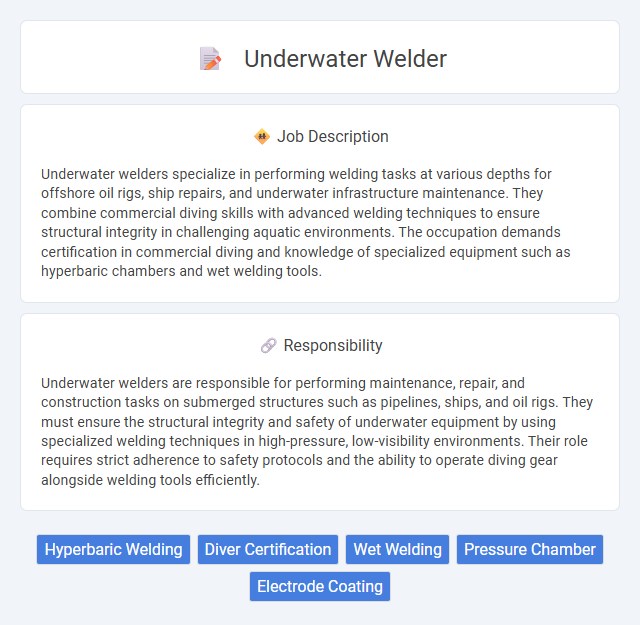
Underwater welders specialize in performing welding tasks at various depths for offshore oil rigs, ship repairs, and underwater infrastructure maintenance. They combine commercial diving skills with advanced welding techniques to ensure structural integrity in challenging aquatic environments. The occupation demands certification in commercial diving and knowledge of specialized equipment such as hyperbaric chambers and wet welding tools.
Underwater welding may suit individuals who are physically fit, comfortable in high-pressure aquatic environments, and capable of handling stress and potential dangers. People with strong swimming skills, good hand-eye coordination, and the ability to remain calm underwater will probably adapt better to this job. Those prone to claustrophobia, respiratory issues, or anxiety in confined spaces might find this occupation less suitable.
Qualification
Underwater welders require specialized training in commercial diving and welding techniques, typically obtained through accredited programs combining both fields. Certification from organizations such as the American Welding Society (AWS) and commercial diving certification from entities like the Association of Diving Contractors International (ADCI) are essential. Strong physical fitness, excellent swimming skills, and knowledge of safety protocols for underwater operations are critical qualifications for this high-risk profession.
Responsibility
Underwater welders are responsible for performing maintenance, repair, and construction tasks on submerged structures such as pipelines, ships, and oil rigs. They must ensure the structural integrity and safety of underwater equipment by using specialized welding techniques in high-pressure, low-visibility environments. Their role requires strict adherence to safety protocols and the ability to operate diving gear alongside welding tools efficiently.
Benefit
Underwater welders likely experience high earning potential due to the specialized skills required in this demanding profession. The role probably offers unique opportunities for adventure and travel, given that projects can be located in various underwater environments worldwide. Safety measures and advanced technology may enhance job security and reduce risk compared to traditional welding roles.
Challenge
Underwater welding likely poses significant challenges due to the hazardous environment, including high pressure, low visibility, and risk of drowning or decompression sickness. The job probably demands advanced technical skills, physical endurance, and strict adherence to safety protocols. These factors may make underwater welding one of the most demanding and risky professions in the welding industry.
Career Advancement
Underwater welders with advanced certifications in hyperbaric welding and commercial diving experience often progress to supervisory roles or specialized positions such as underwater inspection and repair specialists. Gaining additional expertise in pipeline welding and offshore oil rig maintenance significantly enhances career opportunities and earning potential. Continuous training in new diving technologies and safety protocols is essential for long-term advancement and leadership within the underwater welding industry.
Key Terms
Hyperbaric Welding
Hyperbaric welding involves performing welding tasks underwater at depths where high pressure affects the welding process, commonly used in offshore oil rigs, ship repair, and underwater pipelines. This specialized job requires knowledge of diving techniques, welding skills, and safety protocols to prevent hazards like decompression sickness and electric shock. Mastery of hyperbaric welding boosts structural integrity of underwater constructions by ensuring corrosion-resistant and strong metal joints under extreme conditions.
Diver Certification
Underwater welders require specialized Diver Certification such as the Commercial Diver Certification from organizations like the Association of Diving Contractors International (ADCI) or the International Marine Contractors Association (IMCA). This certification ensures proficiency in both diving techniques and welding skills, emphasizing safety protocols and underwater inspection knowledge. Obtaining certification involves rigorous training in hazardous underwater environments and mastering tools essential for subsea construction and repair.
Wet Welding
Wet welding is a specialized underwater welding technique where the welder performs high-quality metal fusion directly in an open water environment, often at substantial depths. This method is crucial for offshore industries such as oil rigs, ship repair, and underwater pipeline maintenance, requiring expertise in handling underwater arc welding equipment and strict adherence to safety protocols. The job demands strong physical endurance, diving certification, and proficiency in managing the challenges of underwater pressure and limited visibility.
Pressure Chamber
Underwater welders frequently utilize pressure chambers to simulate deep-sea conditions and ensure safety during hyperbaric welding operations. These chambers maintain controlled atmospheric pressure, allowing welders to work effectively while minimizing risks such as decompression sickness. Mastery of pressure chamber protocols is essential for underwater welders to perform high-quality, durable welds in challenging underwater environments.
Electrode Coating
Underwater welders rely heavily on high-quality electrode coatings to ensure strong, durable welds in challenging aquatic environments. Specialized coatings provide enhanced slag removal, corrosion resistance, and arc stability, critical for maintaining weld integrity underwater. Proper selection of electrode coatings directly impacts the safety and longevity of underwater structures such as pipelines, ships, and offshore platforms.
 kuljobs.com
kuljobs.com